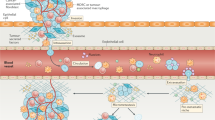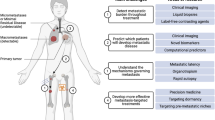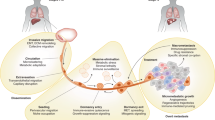Abstract
Great progress has been made in cancer therapeutics. However, metastasis remains the predominant cause of death from cancer. Importantly, metastasis can manifest many years after initial treatment of the primary cancer. This is because cancer cells can remain dormant before forming symptomatic metastasis. An important question is whether metastasis research should focus on the early treatment of metastases, before they are clinically evident (“overt”), or on developing treatments to stop overt metastasis (stage IV cancer). In this commentary we want to clarify why it is important that all avenues of treatment for stage IV patients are developed. Indeed, future treatments are expected to go beyond the mere shrinkage of overt metastases and will include strategies that prevent disseminated tumor cells from emerging from dormancy.

Similar content being viewed by others
References
Brown M et al (2018) Lymph node blood vessels provide exit routes for metastatic tumor cell dissemination in mice. Science 359:1408–1411. https://doi.org/10.1126/science.aal3662
Pereira ER et al (2018) Lymph node metastases can invade local blood vessels, exit the node, and colonize distant organs in mice. Science 359:1403–1407. https://doi.org/10.1126/science.aal3622
Pantel K, Brakenhoff RH, Brandt B (2008) Detection, clinical relevance and specific biological properties of disseminating tumour cells. Nat Rev Cancer 8:329–340. https://doi.org/10.1038/nrc2375
Wan JCM et al (2017) Liquid biopsies come of age: towards implementation of circulating tumour DNA. Nat Rev Cancer 17:223–238. https://doi.org/10.1038/nrc.2017.7
Sosa MS, Bragado P, Aguirre-Ghiso JA (2014) Mechanisms of disseminated cancer cell dormancy: an awakening field. Nat Rev Cancer 14:611–622. https://doi.org/10.1038/nrc3793
Borgen E et al (2018) NR2F1 stratifies dormant disseminated tumor cells in breast cancer patients. Breast Cancer Res 20:120. https://doi.org/10.1186/s13058-018-1049-0
Goss PE, Chambers AF (2010) Does tumour dormancy offer a therapeutic target? Nat Rev Cancer 10:871–877
Aguirre-Ghiso JA, Bragado P, Sosa MS (2013) Metastasis awakening: targeting dormant cancer. Nat Med 19:276–277. https://doi.org/10.1038/nm.3120
Polzer B, Klein CA (2013) Metastasis awakening: the challenges of targeting minimal residual cancer. Nat Med 19:274–275. https://doi.org/10.1038/nm.3121
von Minckwitz G et al (2017) Adjuvant pertuzumab and trastuzumab in early HER2-positive breast cancer. New Engl J Med 377:122–131. https://doi.org/10.1056/NEJMoa1703643
Wolchok J (2018) Putting the immunologic brakes on cancer. Cell 175:1452–1454. https://doi.org/10.1016/j.cell.2018.11.006
Sosa MS (2016) Dormancy programs as emerging antimetastasis therapeutic alternatives. Mol Cell Oncol 3:e1029062. https://doi.org/10.1080/23723556.2015.1029062
Carlson P et al (2019) Targeting the perivascular niche sensitizes disseminated tumour cells to chemotherapy. Nat Cell Biol. https://doi.org/10.1038/s41556-018-0267-0
Ghajar CM (2015) Metastasis prevention by targeting the dormant niche. Nat Rev Cancer 15:238–247. https://doi.org/10.1038/nrc3910
Pastoriza JM et al (2018) Black race and distant recurrence after neoadjuvant or adjuvant chemotherapy in breast cancer. Clin Exp Metastasis. https://doi.org/10.1007/s10585-018-9932-8
Karagiannis GS, Condeelis JS, Oktay MH (2018) Chemotherapy-induced metastasis: mechanisms and translational opportunities. Clin Exp Metastasis 35:269–284. https://doi.org/10.1007/s10585-017-9870-x
Karagiannis GS et al (2017) Neoadjuvant chemotherapy induces breast cancer metastasis through a TMEM-mediated mechanism. Sci Transl Med. https://doi.org/10.1126/scitranslmed.aan0026
El Rayes T et al (2015) Lung inflammation promotes metastasis through neutrophil protease-mediated degradation of Tsp-1. Proc Natl Acad Sci USA 112:16000–16005. https://doi.org/10.1073/pnas.1507294112
De Cock JM et al (2016) Inflammation triggers Zeb1-dependent escape from tumor latency. Cancer Res 76:6778–6784. https://doi.org/10.1158/0008-5472.CAN-16-0608
Pommier A et al (2018) Unresolved endoplasmic reticulum stress engenders immune-resistant, latent pancreatic cancer metastases. Science. https://doi.org/10.1126/science.aao4908
Fluegen G et al (2017) Phenotypic heterogeneity of disseminated tumour cells is preset by primary tumour hypoxic microenvironments. Nat Cell Biol 19:120–132. https://doi.org/10.1038/ncb3465
Chery L et al (2014) Characterization of single disseminated prostate cancer cells reveals tumor cell heterogeneity and identifies dormancy associated pathways. Oncotarget 5:9939–9951
Author information
Authors and Affiliations
Consortia
Corresponding author
Additional information
Publisher's Note
Springer Nature remains neutral with regard to jurisdictional claims in published maps and institutional affiliations.
Rights and permissions
About this article
Cite this article
Zijlstra, A., Von Lersner, A., Yu, D. et al. The importance of developing therapies targeting the biological spectrum of metastatic disease. Clin Exp Metastasis 36, 305–309 (2019). https://doi.org/10.1007/s10585-019-09972-3
Received:
Accepted:
Published:
Issue Date:
DOI: https://doi.org/10.1007/s10585-019-09972-3




